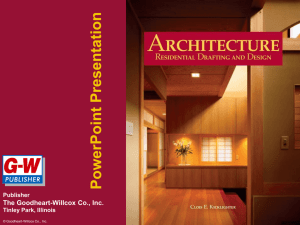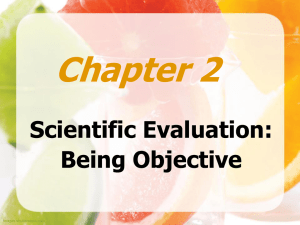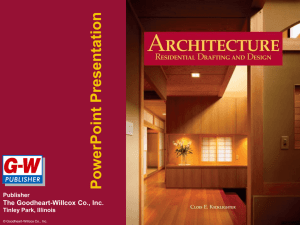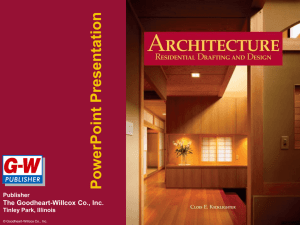Chapter 1 - Goodheart
advertisement
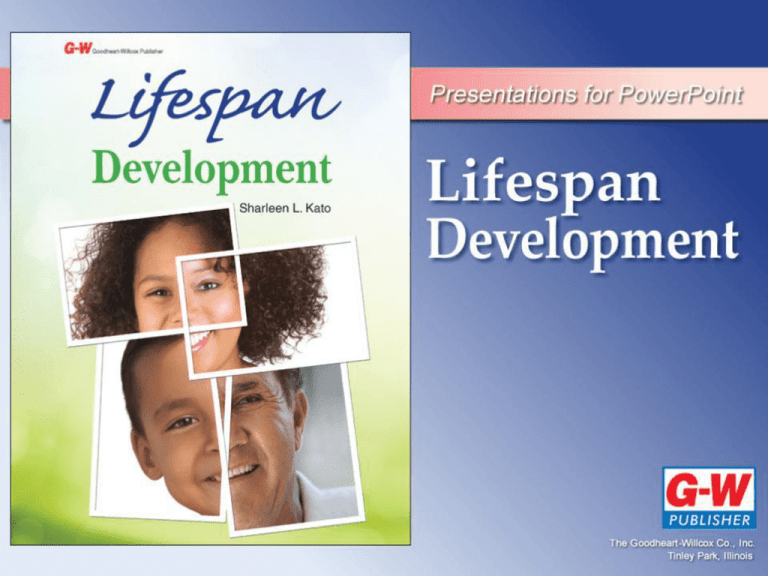
Chapter 1 An Introduction to Lifespan Development Objectives • Discuss how human development involves physical, intellectual, and socio-emotional development. • Identify how development occurs in an orderly and gradual manner. • Describe how every person’s rate and timing of development is unique. continued © Goodheart-Willcox Co., Inc. Permission granted to reproduce for educational use only. Objectives • Explain how physical, intellectual, and socioemotional development are interrelated. • Summarize the current issue of nature versus nurture in human development. • Compare and contrast pedagogy and andragogy. © Goodheart-Willcox Co., Inc. Permission granted to reproduce for educational use only. What Is Human Development? • People grow and change throughout their lives • Human development is a gradual process in which people change from birth through adulthood • Throughout adulthood, people continue to develop and change from young adulthood all the way through old age © Goodheart-Willcox Co., Inc. Permission granted to reproduce for educational use only. Checkpoint 1. What is human development? the gradual process through which humans change from birth to adulthood 2. List six skills children often learn during the first five years of life. (List six:) to roll, crawl, stand, walk, run, hop, skip, laugh, talk, joke, sing, feed themselves, trust, interact with others, count, spell, write, build friendships, care for others, be industrious, show self-control, organize their activities continued © Goodheart-Willcox Co., Inc. Permission granted to reproduce for educational use only. Checkpoint 3. When do people often learn independence and begin to process more complex ideas? as teens © Goodheart-Willcox Co., Inc. Permission granted to reproduce for educational use only. Types of Development • The average lifespan in the 21st Century is 78 years • Almost 30 years longer than the life expectancy in the previous century • Nutrition, medicine, better sanitization, and lifestyles have all contributed to this increased lifespan continued © Goodheart-Willcox Co., Inc. Permission granted to reproduce for educational use only. Types of Development • In each stage of life, people can be described by their physical, cognitive, and socio-emotional differences • Physical development is the changes in size, body composition, chemical make-up, and height that occur as humans develop from birth to adulthood continued © Goodheart-Willcox Co., Inc. Permission granted to reproduce for educational use only. Types of Development • All people grow and change physically at different rates • Scientists and researchers agree on general guidelines or expectations of which changes are common in each stage of development • Individually, people differ in balance, strength, coordination, and energy levels to perform both gross- and fine-motor skills continued © Goodheart-Willcox Co., Inc. Permission granted to reproduce for educational use only. Types of Development • Gross-motor skills involve large muscle movements such as crawling, walking, and jumping • Fine-motor skills involve small muscle movements such as cutting with scissors and writing with a pen or pencil continued © Goodheart-Willcox Co., Inc. Permission granted to reproduce for educational use only. Types of Development • Actions or processes that involve thinking and knowing are called cognition • The way people change and grow in how they think is called cognitive development • Part of cognitive development is the advance and expansion of the use of language • In moral development, people are able to approach problems based on their life stage continued © Goodheart-Willcox Co., Inc. Permission granted to reproduce for educational use only. Types of Development • Socio-emotional development refers to changes related to a person’s – social relationships – feelings – social skills – self-esteem – gender identity – ways of coping with situations © Goodheart-Willcox Co., Inc. ©Rob Hainer/Shutterstock.com Permission granted to reproduce for educational use only. Checkpoint 1. List the three major ways in which people develop over time. physically, cognitively, and socio-emotionally 2. Define gross-motor skills and fine-motor skills. Give an example of each. Gross-motor skills are physical tasks involving large muscle movements such as crawling or jumping. Fine-motor skills are physical tasks involving small muscle movements, such as cutting with scissors or writing with a pen or pencil. continued © Goodheart-Willcox Co., Inc. Permission granted to reproduce for educational use only. Checkpoint 3. What is cognition? all of the actions or processes involving thinking and knowing 4. Define socio-emotional development. changes in the way a person’s social relationships, feelings, social skills, selfesteem, gender identity, and ways of coping with situations develop from birth through older adulthood © Goodheart-Willcox Co., Inc. Permission granted to reproduce for educational use only. Principles of Human Development • Over the years, what people know about human development continues to change • Human development is relatively orderly • Understanding the orderly stages of development helps you deal with people in a manner that is appropriate to their abilities and understanding continued © Goodheart-Willcox Co., Inc. Permission granted to reproduce for educational use only. Principles of Human Development • Human development takes place gradually • While some changes occur within minutes, most changes take weeks, months, or years to complete • The physical changes that occur from birth through adolescence are enormous • Brain development and cognitive changes also occur over time continued © Goodheart-Willcox Co., Inc. Permission granted to reproduce for educational use only. Principles of Human Development • Human development is interrelated • Physical, cognitive, and socio-emotional development occur together • Maslow’s Theory of Human Needs arranges the types of needs in five levels • Maslow believed that a person cannot meet higher-level needs until basic needs are met continued © Goodheart-Willcox Co., Inc. Permission granted to reproduce for educational use only. Principles of Human Development ©Goodheart-Willcox Publisher continued © Goodheart-Willcox Co., Inc. Permission granted to reproduce for educational use only. Principles of Human Development • Although development is orderly, the outcomes and rate of development vary by individual • Many different factors cause these differences • Genetics and heredity (traits people are born with) are different for everyone continued © Goodheart-Willcox Co., Inc. Permission granted to reproduce for educational use only. Principles of Human Development • A person’s experiences and environment (all of a person’s surroundings and the people in them) are not exactly the same as those of others • Because both heredity and environments influence development and no one is exactly alike, individual variations in developmental characteristics are expected © Goodheart-Willcox Co., Inc. Permission granted to reproduce for educational use only. Checkpoint 1. Name the four basic guidelines about how people develop. Give an example of each. human development is relatively orderly, takes place gradually, is interrelated, and varies among individuals (Examples will vary.) 2. How can understanding the orderly stages of development help you deal with people in a manner that is appropriate to their abilities and understanding? relatively accurate and useful predictions can be made about people based on their present and future stages in life continued © Goodheart-Willcox Co., Inc. Permission granted to reproduce for educational use only. Checkpoint 3. According to Maslow, what are the five levels of human needs? physical needs, security, love and acceptance, esteem, and self-actualization 4. List two factors that cause human development to vary among individuals. heredity and environment © Goodheart-Willcox Co., Inc. Permission granted to reproduce for educational use only. Key Issues in Development • A fascination with how people grow and change over time is evident in people’s interest in those around them • Movie stars and other news generators are sources of interest and speculation • As a person’s fame rises, the questions often increase continued © Goodheart-Willcox Co., Inc. Permission granted to reproduce for educational use only. Key Issues in Development • This interest highlights three important issues in human development • The debate between genetic versus environmental influences on development is called the nature versus nurture debate • This is the choice between heredity as a source of development and the environment continued © Goodheart-Willcox Co., Inc. Permission granted to reproduce for educational use only. Key Issues in Development • Continuity versus discontinuity is another issue in human development • Developmental changes can be relatively slow, but steady • This process of development is called continuity for its stable nature continued © Goodheart-Willcox Co., Inc. Permission granted to reproduce for educational use only. Key Issues in Development • A process of development that is spurred by abrupt changes is called discontinuity • Both continuities and discontinuities are likely to affect a person’s development • People may be born with certain tendencies, but as they experience different life events, they change and adapt as necessary continued © Goodheart-Willcox Co., Inc. Permission granted to reproduce for educational use only. Key Issues in Development • A third issue is pedagogy versus andragogy • Some people believe that human growth and development relies heavily on another person guiding or mentoring learning • This teacher- or parent-directed method of learning is often referred to as pedagogy continued © Goodheart-Willcox Co., Inc. Permission granted to reproduce for educational use only. Key Issues in Development • Some people believe that development is self-directed from the earliest stages of infancy • This is termed andragogy • Probably a combination of both pedagogy and andragogy occur © Goodheart-Willcox Co., Inc. Permission granted to reproduce for educational use only. Checkpoint 1. Make a list of some of your own personal characteristics and describe whether the traits are a result of nature or nurture. (Answers will vary.) 2. Define the terms continuity and discontinuity. Continuity describes developmental changes that are relatively slow, but steady. Discontinuity is the process of development, spurred by abrupt changes. continued © Goodheart-Willcox Co., Inc. Permission granted to reproduce for educational use only. Checkpoint 3. Compare and contrast pedagogy and andragogy. Pedagogy is teacher- or parent-directed learning. Andragogy is self-directed learning. 4. What are you learning through pedagogy? What are you learning through andragogy? (Answers will vary.) © Goodheart-Willcox Co., Inc. Permission granted to reproduce for educational use only. Why Study Human Development? • Studying human development gives insight into what to expect of people based on their stage of development • This understanding may enhance relationships • You will also have more insight into your own life and be better able to consider choices © Goodheart-Willcox Co., Inc. Permission granted to reproduce for educational use only. Checkpoint 1. How will studying human development help you as you interact with people daily? by giving insight into what to expect of people based on their stage of development 2. How will studying human development enhance your relationships with others? by giving the ability to appreciate and relate to people at different stages of development continued © Goodheart-Willcox Co., Inc. Permission granted to reproduce for educational use only. Checkpoint 3. How can studying human development affect your life? by being better able to appreciate and relate to people at different stages of development and by having more insight into your own life both now and in the future, which may influence choices about the future © Goodheart-Willcox Co., Inc. Permission granted to reproduce for educational use only.
